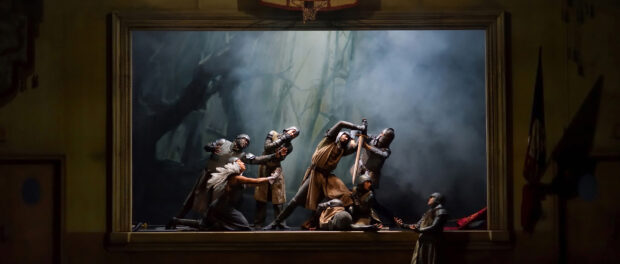Kidd Pivot’s Assembly Hall: commit to the Quest!
Kidd Pivot
Kidd Pivot’s Assembly Hall offers both a glimpse into the arcane world of medieval re-enactment and, more so, an in-depth exploration of human universality: what brings us together, what keeps us apart, the little quirks that make us who we are, the broader ways in which we are all interconnected and interdependent.
Building on some of the ideas she explored in Revisor, choreographer Crystal Pite takes everyday movements—shrugs, hand gesticulations, gestures that usually go under the radar of perception—and turns them into dance. Along with playwright Jonathon Young, she creates in Assembly Hall a work of dance-theatre that alludes to other forms of art as well, including film, television, painting, music . . . and medieval re-enactment.
Assembly Hall takes place at the Annual General Meeting of a medieval re-enactment company fallen on hard times. The meeting is held in a school gym complete with a basketball net, a curtained stage, and a large medieval flag in an outrigger on the wall. As the participants enter the dingy space, and the meeting is eventually called to order, we are introduced to the stock figures that make up any community theatre-type management: the Chair, the Treasurer, the Community Outreach person. The pre-recorded dialogue gives us insight into each personality; Pite’s careful study of minute gestures fleshes out the characters, telling us more than words can.
We come to learn that this will be the final AGM: the group has to vote, during this meeting, on its own dissolution. Over the course of the 1.5-hour work we see sides being taken; we also see that profound undercurrents of emotion underlie the banal formalities of the assembly.
As the meeting gets underway, each new banality (reviewing the minutes from last time, discussing the coffee break, and so on) dissolves into a surreal parallel universe whose drama far exceeds the limits of an AGM (although some of the early rifts in the narrative certainly reflect the sheer frustration, boredom and madness of sitting through meetings such as this one). Soon these moments of dissolution themselves become actual medieval re-enactments, replete with damsels in distress, knights in shining armour, swordfights, and dark and desolate forests. Given the hallucinatory affect of these segments, meaning is hard to pin down. It seems that the conflicts, the alliances, the stories of love and heartbreak that are being enacted in the medieval re-enactment parts parallel the heartfelt struggles of the medieval re-enactment company itself, which themselves parallel all human attempts at connection, consensus, and action. In the end, it’s impossible to say where the reality actually lies: with the re-enactments, in the meeting, or in the abstract metaphorical realities? Clearly reality is comprised of what we see consciously, as well as what lies under the surface, visible only when subconscious forces bubble up to create art.
One of Pite’s most impressive accomplishments is her ability to create a moving tableau, a painting in motion. During the scenes of medieval re-enactment, she evokes Renaissance paintings of ancient battles and still-lifes, bringing them to life, enacting them. There are also moments that evoke old black and white films. And when the action is on the gym stage, the extra frame might be a television screen. The soundtrack, featuring originally composed music as well as Tchaikovsky’s Piano in Concerto in B flat, is completely integrated with the movement and the shifting realities. Passing moments of aural static provoke juddering movements in the dancers’ limbs and bodies, reminding us that reality may be a simulation, and if we pay close enough attention we’ll see the glitches in the matrix.
Much of the drama, both during the meeting scenes and during the re-enactments, involves the soft-spoken, uncommitted, almost Charlie-Brown-like Dave. Dave is the least implicated of all the committee members; he seems unsure of whether he should be there. Indeed everyone seems unsure about whether he is actually there or not. As it turns out, his will be the deciding vote on whether or not the group’s plan to dissolve is postponed for another year.
During the part of the meeting where the community outreach team is showing the plan they’ve come up with to draw new people to the group’s main event—Quest Fest—Dave is volunteered by the others to pretend to be a new recruit. He grudgingly consents, and dons a knight’s helmet. He goes along half-heartedly until, as the scene dissolves into a re-enactment, Dave realizes that it’s all up to him: he can save the damsel in distress; he can fix her broken heart (it seems likely that he in fact was the one who broke her heart to begin with); he just has to get back to the Assembly Hall and put things right. But is it possible to change the narrative? Is it too late? Did he miss his chance to play a part, to have a say in his own life?
Dave’s newfound agency brings everything to a head: he comes back to the meeting as a full-fledged knight, covered head to toe in blinding armour. And then . . . he is killed by the others, stabbed with a long jousting sword. His armor is distributed among the other members, who come together to reconstruct its shining surface. But he is no longer there behind the armour: only they are. His absence, implied from the opening scene, comes fully to fruition. Only Dave’s armour remains. And with everyone hiding behind it, the company dissolves and the work comes to an end. One thing is certain: only in fully committing himself to the Quest, did Dave come fully alive.
Kidd Pivot was at Théâtre Maisonneuve 29 November-2 December.






